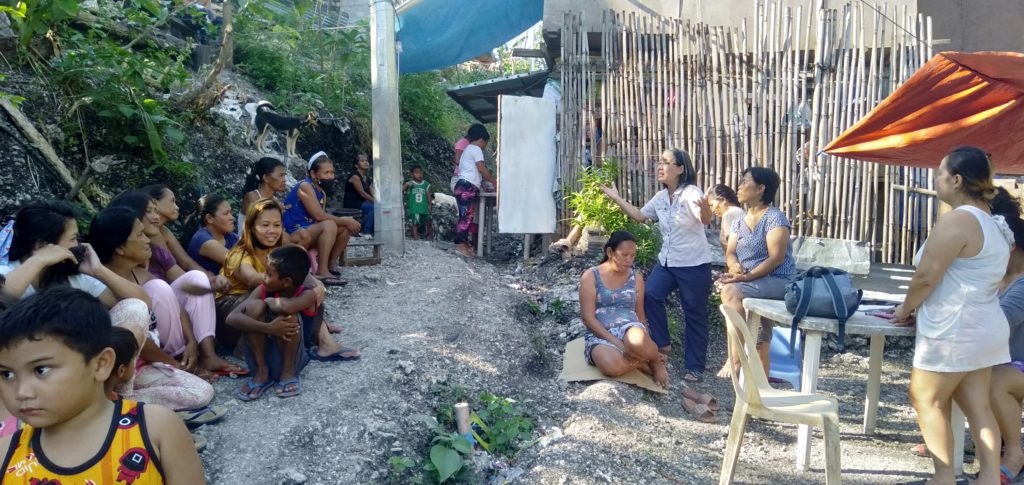The Visayas Primary Healthcare Services, Inc. (VPHCS) recently rendered a series of psychosocial services missions to residents in eight barangays affected by Typhoon Yolanda in Medellin and Daanbantayan last August to September and in four barangays in Maribojoc affected by the October 2013 earthquake in Bohol last October.
A team of psychologists, nurses, doctors and health workers of the VPHCS attended to the families in Barangays Antipolo, Mahawak, Tindog and Dalingding Sur in Medellin, and Barangays Dalingding Norte, Tinubdan, Baterya and Malbago in Daanbantayan. The barangays served in Maribojoc included San Isidro, Punta Cruz, Bayacabac, and Tinibgan.
The services are part of a project of the Community Empowerment Resource Network (CERNET) to provide livelihood and social rehabilitation to families in the 12 barangays. The project is funded by the Diakonie Katastrophenhilfe, a humanitarian aid organization in Germany.
In each area, prior to conducting psychosocial counseling through group sessions, the team conducted a lecture on Community Resiliency Model (CRM). The CRM of the Trauma Resource Institute is a skill-based wellness program that helps people to handle the impact of trauma and chronic stress on themselves and restore resiliency. The program which consists of six basic skills enables individuals to understand their nervous system and read sensations connected to their own well-being, which CRM calls the “Resilient Zone.” CRM has widely been used in different countries among individuals and communities affected by economic challenges, natural and human-made disasters and other forms of stress in their day-to-day life, in order to enable them to cope with such stress, or change their situation by increasing their resiliency. Many individuals have also used it to reduce anxiety, depression and stress.
Using the CRM, the team members were able to identify individuals who were still affected by trauma resulting from their experiences during Typhoon Yolanda and the earthquake and help them overcome it.
In every community, the residents were asked to gather together and listen to lectures on CRM conducted by the team members. The lectures were conducted in the local Cebuano dialect and aided by powerpoint presentations. Interactions and open forum with the audience were interspersed during the lectures. They were lively exchanges between the audience and the facilitators.
Before the lectures, copies of a checklist of symptoms related with reaction to trauma were distributed to the residents. Symptoms included difficulty of sleep, headache, nightmares, irritability, stomach ache, anxiety, diarrhea, withdrawal, and loss of appetite. By recalling their symptoms during the lectures, they would realize that they can use the CRM skills in order to overcome their symptoms.
After the lectures, the residents were then asked to group themselves into 8 – 10; each group was facilitated by a VPHCS team member.
In each group, the facilitator had the checklists of the individuals who were present in the group. Using the checklists, the concerned individual with the symptoms were asked to share about his symptoms, how often they would occur, and in what occasions would they occur. The facilitator then used CRM to help the individual process his trauma.
Generally, the residents in the 12 barangays said that they have recovered from the trauma they had due to Typhoon Yolanda and the earthquake. However, the teams were able to identify a few cases of post traumatic stress disorder.
These cases were all referred to psychologists who were in the teams and psychosocial counseling was done among them.
In each barangay, the children had psychosocial activities. Play therapy was used by the facilitator to engage a group of children in play that enabled them to draw out any ill feelings such as fear and anger. The facilitator then processed the emotions expressed during the play. Art therapy was also used by the children to express their feelings through drawings after which the facilitator processed the projections of the children. The children enjoyed their play and art therapy as they shared their drawings to everyone. They also shared experiences during the disaster.
Generally however, the children did not exhibit any abnormal behaviour during their play and drawing sessions.
After the psychosocial session in each barangay, all the residents joined a culminating activity wherein they formed a big circle and participated in a ceremony which expressed their gratitude to their Creator for all their blessings, that they are all right, that they have moved on with life.
Each one went home happy with the day’s activity.



